
It is a fact, the first plane was a biplane designed by the Wright Brothers at Kitty Hawk, North Carolina. These planes never saw the light of day when the jet age came about, landing them a spot in museums instead.
Things are about to change, however, as these archaic bi-plane designs will be resurrected with a retro-modernized re-design for supersonic transport. A good chance exists that it might be the supersonic Concorde of the future, that is if everything pans out fine. It will be designed with features of a bi-plane configuration that will cancel out supersonic shock waves more efficiently.
One objective of the project is to engineer a twin wing design for a supersonic jet, with better fuel-efficient and quieter mechanism. Another aspect is to create an experimental design that breaks the sound barrier with less sonic-boom. As jets go beyond Mach 1, they create shock waves when going over the speed of sound.
Two aeronautics and astronautics engineers at MIT were the brains who cobbled up the proposed twin-wing, which will be faster than any sound airplane. Both Qiqi Wang and Rui Hu have proposed a radical design that is straight from airplane history; a biplane like nothing ever designed. The duo made a computer simulation of a bi-level winged design that has less drag when reaching the speed of sound. Their simulation proved better than a normal single-winged plane at supersonic speed.
Mechanics of the double wing design
The design suggested by the engineers from MIT was originally made by German engineer "Adolf Busemann" in the 1950s. Improving on current biplane design during the 50s, Busmann engineered a twin wing that takes away the shock wave effect totally with no more sonic-boom.
Wing configuration of the Busemann design was a twin delta wing over each other, that can negate supersonic shock waves. Tips of the delta wing were almost touching each other, in an almost closed wing design but with a small wingtip gap. By doing this, it will eliminate shock waves from each wing.
The problem of lift in the lack of airflow is solved when reaching sonic speeds, it forces air into the gap to choke and create a drag on the flying wing. This drag is the problem which will disappear when the plane is at sonic speeds.
Busemann's drag problem
To beat the drag problem of the old design, both engineers at MIT discovered by lessening resistance on the inner wing will build up a channel to direct airflow to give more lift. Another is to raise the edge of the higher and lower wing, which allows the conceptual design to reach supersonic ranges easily. Now, this lessened drag better than a Concorde with less fuel used to reach the speed of sound. One major factor to consider is how much weight from the passengers to fuel stored, should be studied for more design improvements. Other researchers using the same concept as the MIT pair, have added transitional wings for subsonic or supersonic flight.
Revision and reinvention of the biplane
Engineers like Qiqi Wang and Rui Hu are creating a new and environmentally efficient fuel, based on Busemann's old design. If the archaic biplane design is more efficient and faster than sound craft, this will the dawn of better supersonic transport for everyone and the environment.
Related Article: Supersonic Biplanes, The Future of Travel?
© 2025 ScienceTimes.com All rights reserved. Do not reproduce without permission. The window to the world of Science Times.











